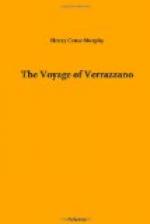Navigando fra levante & tramontana per spatio di leghe 150, PERVENIMO PROPINQUI alla terra Ege per il passato TREVORONO I BRETTONI, quale STA in gradi 50 & havendo horamai consumati tutti li nostri armeggi & vettovaglie, havendo scoperto leghe 700, & piu di nuova terra, fortnitoci di acque & legue, deliberammo tornare in Francia. * * * * * * * * * * * *
Cosmography omitted.
Translation Narrative.
Sayling northeast for the space of 150 leagues we approached to the lande that in times past was discovered by the Britons, which is in FIFTIE degrees. Having now spent all our provision and victuals and having discovered about 700 leagues and more of newe countries, and being furnished with water and wood we concluded to returne into Fraunce. (Hakluyt, Divers voyages).
(Cogswell, Coll. of N. Y. Hist.
Society, Second series, I.)
Ramusio in omitting the cosmography and confining his version to the narrative would have left the letter without any designation of the northerly limit reached by Verrazzano, had he not transferred to the narrative, the statement of the latitude attained, namely, the fiftieth degree, from the cosmographical part; which was therefore properly done; though as an editor he should have stated the fact. But he transcended his duty entirely in asserting, in qualification of the latitude, what does not appear in the letter, that it was near where the Bretons had formerly made discoveries, and omitting all reference to the Portuguese. The Bretons are not mentioned or even alluded to in either portion of the original letter. The effect of this substitution therefore is to relieve the original from making a fake claim to the discovery north of Cape Breton, by admitting the discoveries of the Bretons, and making the alleged extent of the Verrazzano discovery, as already remarked, a mistake of nautical observation only. That it was deliberately made, and for that purpose, is shown by his taking the designation of the latitude from the same sentence in the cosmography as that in which the mention of the Portuguese discoveries occurs, in qualification of the latitude.
The motive which led Ramusio to make this alteration is found in the discourse of the French captain of Dieppe, in which it is stated that this part of the coast was discovered by the Normands and Bretons and the Portuguese, many years before the Verrazzano voyage. Ramusio, as he informs us himself, translated that paper from the French into the Italian and published it in the same volume, in conjunction with the Verrazzano letter, which he remodelled. He thus had the contents of both documents before him, at the same time, and saw the contradiction between them. They could not both be true. To reconcile them, alterations were necessary; and this change was made in the letter in order to make it conform to the discourse. The fact of his making it, proves that he regarded the letter as advancing an indefensible claim.




